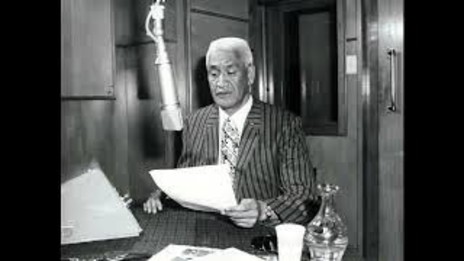Wiremu (Bill) Kerekere
E ngā iwi o te motu tēnā koutou katoa, e ngā whare karioi, nunui mā, roroa mā, e ngā puna waiata, ka nui te mihi i roto i te āhuatanga o te hunga kura ngaro ki te Pō. Okioki mai koutou i roto i te āhuru o te ao kei tua. E mihi ana ki a koutou Te Aitanga a Mahaki, Tūranga-nui-a-Kiwa, Te Tai Rāwhiti. Ko Wiremu Kerekere tēnei, te mūrau a te tini, te wenerau a te mano, e maumaharatia nei, e kōrerotia nei, e whakamihatia nei i tēnei whārangi.
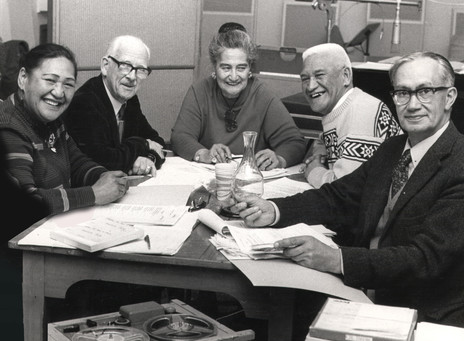
Bill Kerekere and colleagues at the NZBC, c.1970s (from left): Ruby Gray, Leo Fowler, Witarina Harris, Bill Kerekere and Wiremu Parker
Photo credit:
Kerekere whānau collection
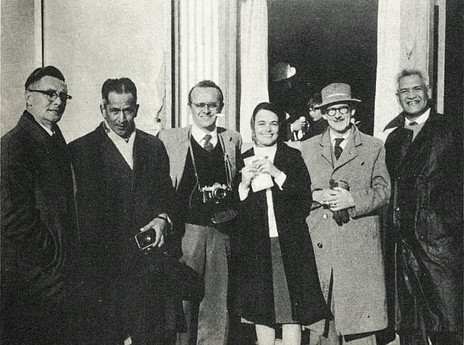
Larry Adler is welcomed to Gisborne on a private visit to explore "the real New Zealand". From left: Gisborne PR officer Mr Clarke, Mr (later Sir) Hēnare Ngata, Larry Adler, Miss Scherman (Adler's companion), Mr Leo Fowler (manager of station 2XG), and Mr Wiremu Kerekere.
Photo credit:
Gisborne Photo News, September 1961

The Waihīrere Māori Club, rehearsing at Waitangi for its performance before Queen Elizabeth II, 1963
Photo credit:
Kerekere whānau collection
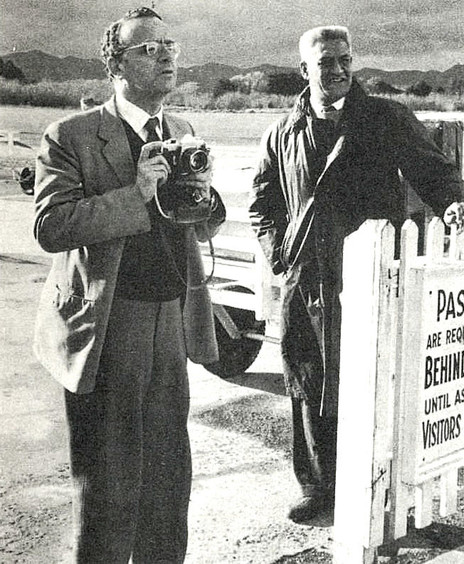
Bill Kerekere with US harmonica virtuoso Larry Adler, at Darton Field airport, Gisborne, in 1961. The Photo News reported that Adler was "an unusual man, whose instrument belongs in the pocket, but whose temperament and outspoken comments on New Zealand suggested the status of a testy genius, Adler indicated that this country was a write-off as far as he was concerned ... all except his Gisborne visit, which he named as the bright spot of his tour."
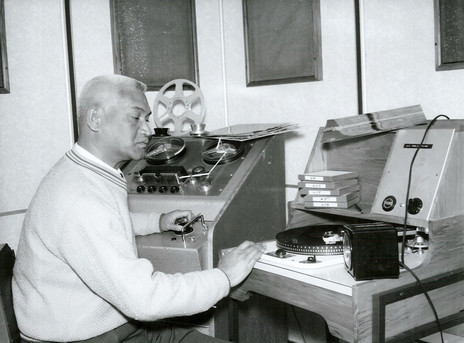
WIremu (Bill) Kerekere preparing a radio programme, 1966
Photo credit:
Archives NZ, R24460988
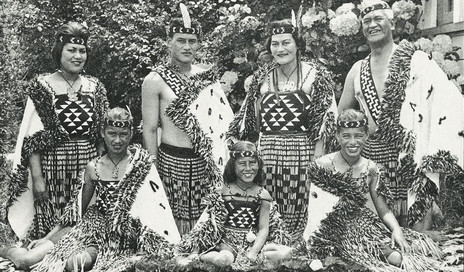
The Kerekere whanau at home, from the Gisborne Photo News, 28 January 1965: "Gisborne, and particularly the Waihīrere Māori Club, lost a popular and respected family when Mr Bill Kerekere left the city earlier this month for Wellington. A talented musician, Mr Kerekere was president of the Waihīrere Club, and was employed with the Māori Affairs Department. He is to work with Mr Leo Fowler, former 2XG station manager, in the Broadcasting Corporation's Māori Programmes Department, compiling material for the national network Wednesday and Friday evening Māori programme." The Kerekere family are (back row, from left): Raana, Ria (Kohi Karauria), Mihi Kerekere, and Wiremu (Bill) Kerekere. In front: Hiki, Ata and Riki.
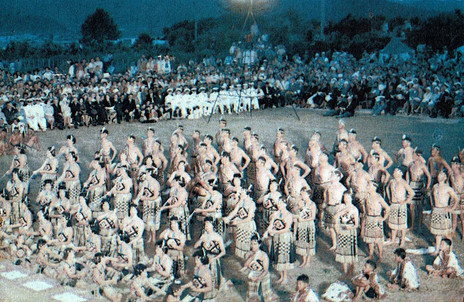
The Waihīrere Māori Club during its performance in front of Queen Elizabeth II, Waitangi, 1963
Photo credit:
Kerekere whānau collection
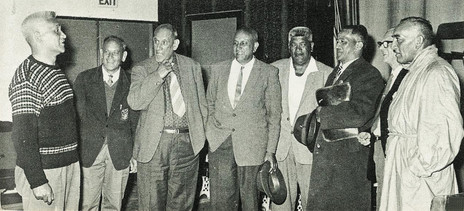
Rangatira of Tairāwhiti visiting a rehearsal of the Waīhirere Māori Club, preparing for its upcoming performance in front of Queen Elizabeth, at Waitangi. Their presence confirmed their support for the man, the mahi and the Waihīrere Māori Club to represent their Rohe. From left: Wiremu (Bill) Kerekere, Pita Kaua, Rongowhakaata Halbert, Arnold Reedy, Ben Brown, Hēnare Ngata, Leo Fowler, and Heta (Barney) Te Kani.
Photo credit:
Gisborne Photo News, January 1963
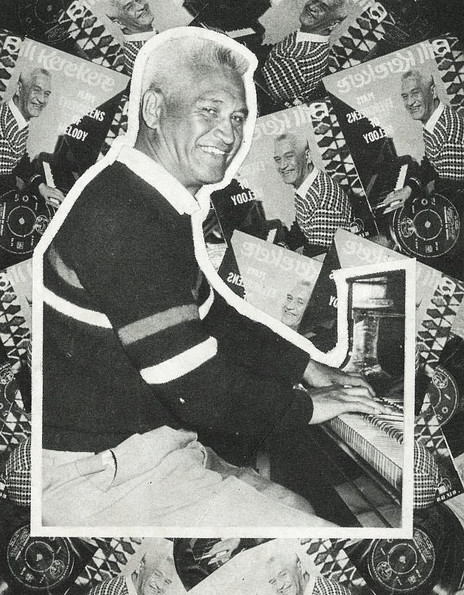
A collage of Bill Kerekere to mark the release of Bill Kerekere Plays Evergreens of Melody (Kiwi EP, 1963). Reported the Gisborne Photo News: "The record has proved a good seller, and could well lead to bigger things for Gisborne's 'reluctant genius' ... the term used to describe Bill by visiting musician, Larry Adler."
Photo credit:
Gisborne Photo News, February 1963
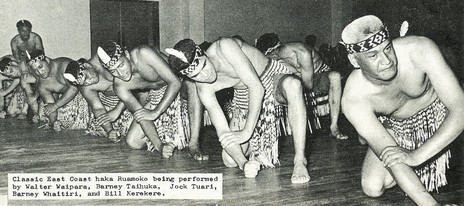
Bill Kerekere, front right, with the Waihīrere Māori Club rehearsing the East Coast haka Ruamoko, to perform in Waitangi in front of Queen Elizabeth II and the Duke of Edinburgh.
Photo credit:
Gisborne Photo News, January 1964
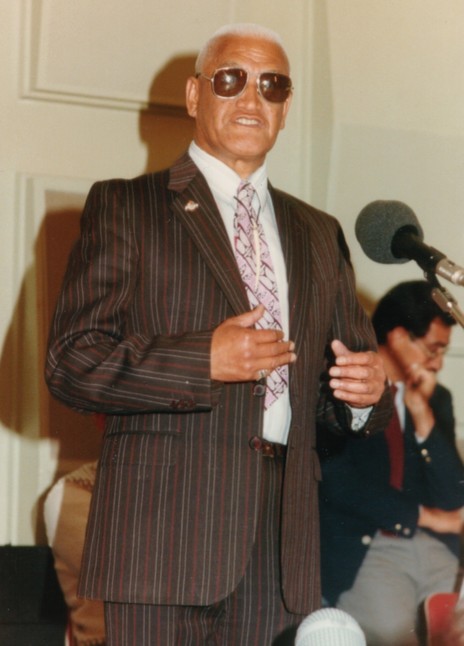
Wiremu (Bill) Kerekere at his retirement from Radio New Zealand, c.1985. In 1992, he said: “Over 40 years I have composed approximately 150-200 original compositions with some good results. The theme or kaupapa of each item is dependent on the purpose, the occasion, the reason for its oral and visual presentation, publicly.”
Photo credit:
Kerekere whānau collection
'Aotearoa' - performed by Wiremu (Bill) Kerekere, who wrote the te reo lyrics. Melody by Cliff Walker.
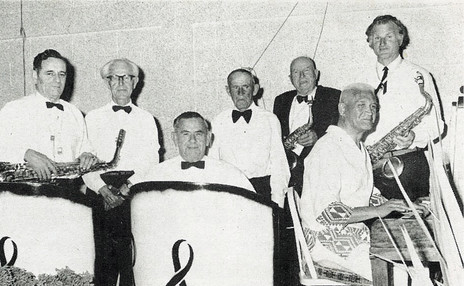
The Ray Zame Orchestra, from left: Ray Zame, Bill Firth, Harry Ratcliffe, Theo Cameron, Herbie Clare, Bill Kerekere, and Sandy Hovell. The band – prominent in Gisborne in the 1950s and 1960s – reunited to help raise money for the Rotary Club to buy a piano as a gift to the city.
Photo credit:
Gisborne Photo News, November 1975

Wiremu (Bill) Kerekere performing a whaikōrero.
Photo credit:
Kerekere whānau collection
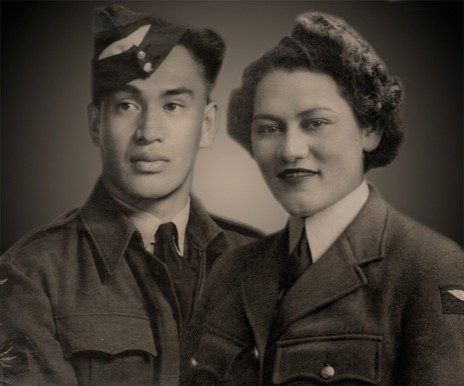
The soldier and the WAAF: Wiremu (Bill) and Mihi Kerekere. "He was stationed at Trentham and she was stationed at Wigram," says their oldest daughter, Raana Tangira. "They met somehow, somewhere."
Photo credit:
Kerekere whānau collection
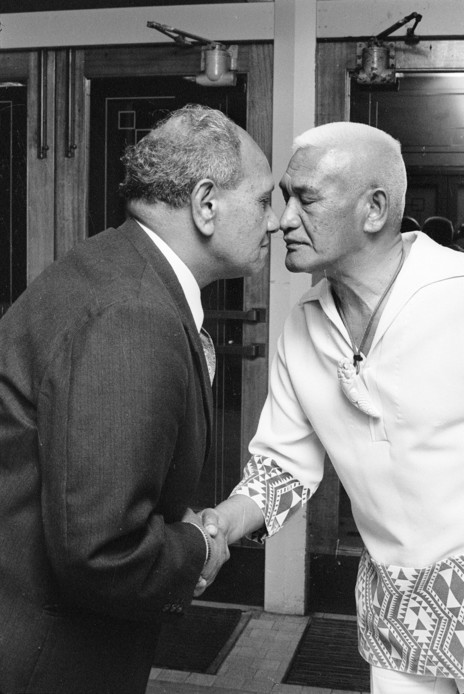
Manaaki Whaanga and Wiremu Kerekere hongi at the Maori Leadership Ball, Wellington, 1977
Photo credit:
Ross Giblin, Evening Post/Dominion collection, Alexander Turnbull Library, Wellington. Ref: EP/1977/4513/22-F
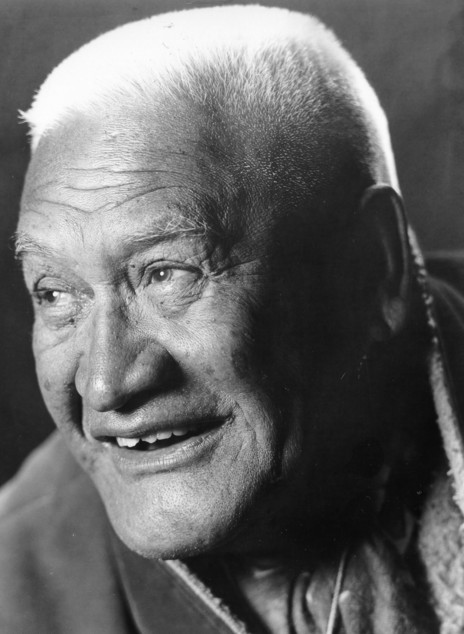
Wiremu (Bill) Kerekere.
Photo credit:
Kerekere whānau collection
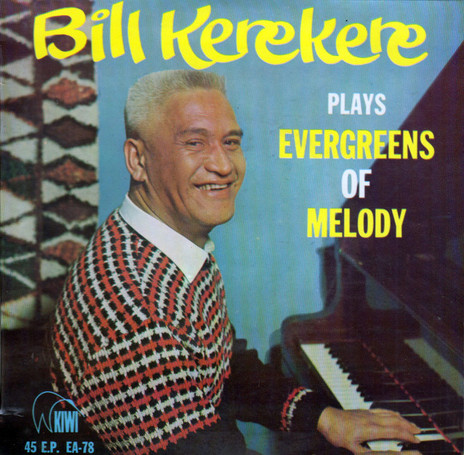
Bill Kerekere Plays Evergreens of Melody – this 1963 EP on Kiwi featured six standards, including ‘The Lady is a Tramp’, ‘I Only Have Eyes For You’ and ‘S’Wonderful’. Kerekere was on piano, backed by bassist Tony Eagleton and drummer Harry McConnachie (both from Tony and the Initials).
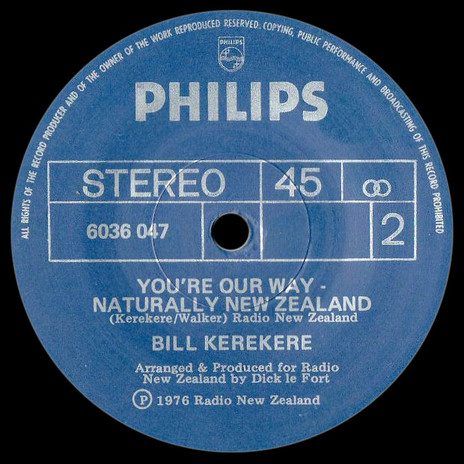
In 1976 Bill Kerekere wrote recorded ‘Aotearoa’ – a reo interpretation of ‘You’re Our Way – Naturally New Zealand’. Both songs were released on a Philips (NZ) single, with Desna Sisarich singing the English version on one side, and Kerekere singing ‘Aotearoa’ on the other.
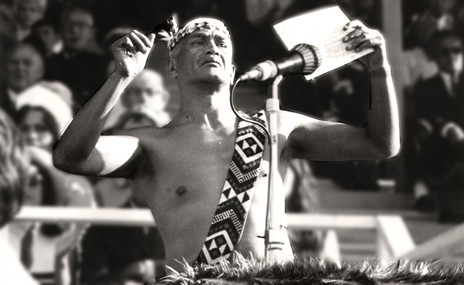
Bill Kerekere leading a mass pōhiri for Queen Elizabeth and the Duke of Wellington at the Royal Festival held at Rugby Park, Gisborne, 1977.
Photo credit:
Kerekere whānau collection
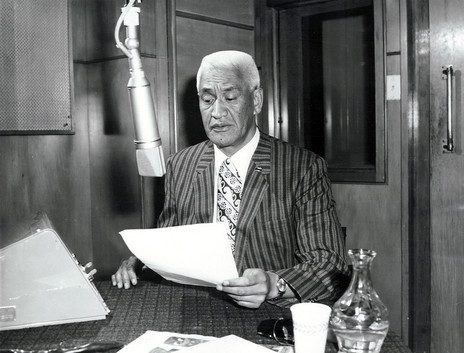
Wiremu (Bill) Kerekere recording a radio script, 1966
Photo credit:
Archives NZ, R24804408
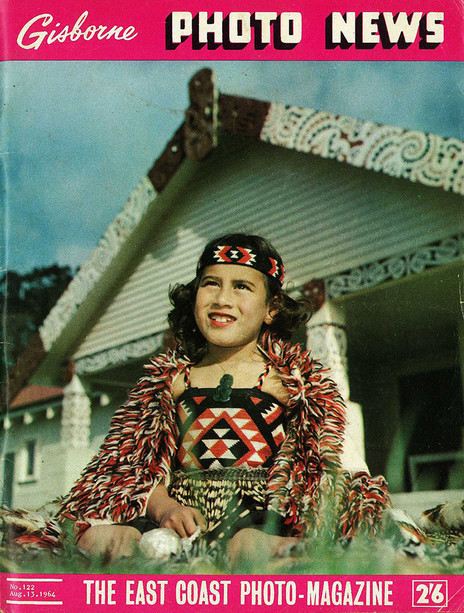
From the Gisborne Photo News, 13 August 1964: "Six-year-old Ata Moana Kerekere [now Kerekere-Campbell], the delightful little 'star' of the Waīhirere Māori Concert Party, is the subject of our colour cover this month. The daughter of Mr and Mrs Bill Kerekere, 75 Stout Street, she made her first appearance with the club's primary group at the age of four, when they won their section in the annual Māori competitions."
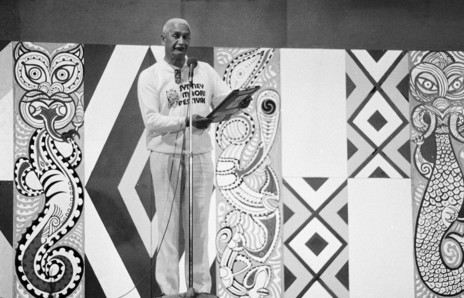
Bill Kerekere announces acts at the New Zealand Polynesian Festival held at Tomoana Showgrounds, Hastings, February, 1983.
Photo credit:
Jocelyn Carlin collection, Alexander Turnbull Library, Wellington. Ref: 35mm-120810-13
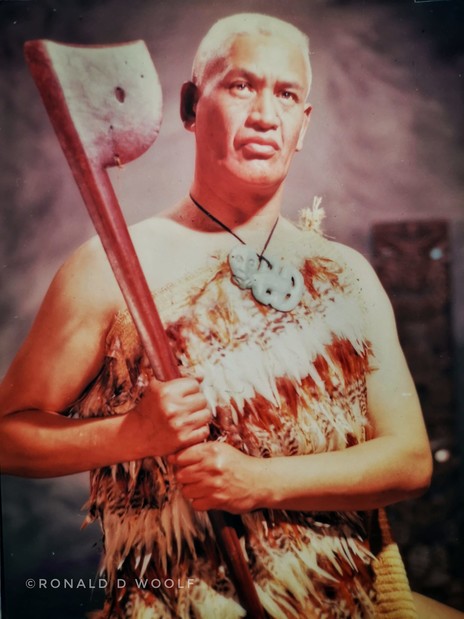
Wiremu (Bill) Kerekere - a portrait by Ronald D Woolf.
Photo credit:
© Woolf Photography
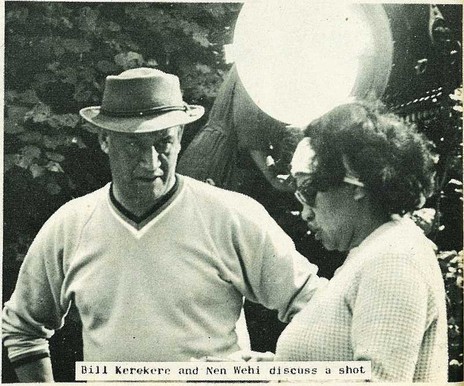
Bill Kerekere and Nen (Pimia) Wehi on the set of a TV film being made about the Waīhirere Māori Club, directed by Derek Wright. Waīhirere Domain, Labour Weekend, 1964
Photo credit:
Gisborne Photo News, November 1964

Members of the Gisborne Jaycees and the composite Jaycee and Waīhirere Māori Club committee which organised the 1964 visit of Miss New Zealand, Elaine Miscall. From left, at rear: Dick Prosser and Wiremu (Bill) Kerekere. Middle row: Howard Piesse, Leo Fowler, Tony Chrisp, and Doug Kerr. Front row: Veniana Waga, B Chrisp, Mihi Kerekere, Elaine Miscall, B Kerr and H Piesse.
Photo credit:
Gisborne Photo News, February 1964
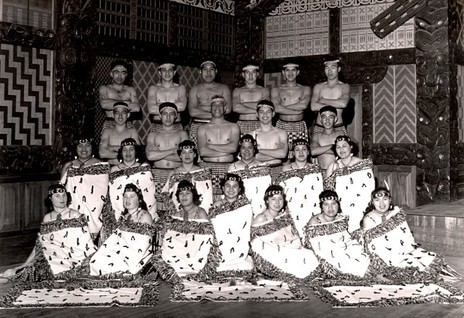
The Waihīrere Māori Club in the 1950s at Te Poho o Rawiri. Back row, from left: Joe Koopu, Bub (Ngapo) Wehi, Tuta Kainamu, George Nepe, Mitch Roger, unidentified. Row three: Theo Ria, Bob Bartlett, Bill Kerekere, David Marino, Wally Te Ua. Row two: Nen (Pimia) Wehi (née Te Ua), Girlie Marino, Arohea Mita (Katipa), Ani Taihuka, Nellie Leach (Katipa), Mihi Kerekere (Parata). Front row: unidentified, Blossom Marino, Vivian Rogers, Marama Taihuka, unidentified, Veronica Roger, Charlotte Pohatu
Photo credit:
Kerekere whānau collection
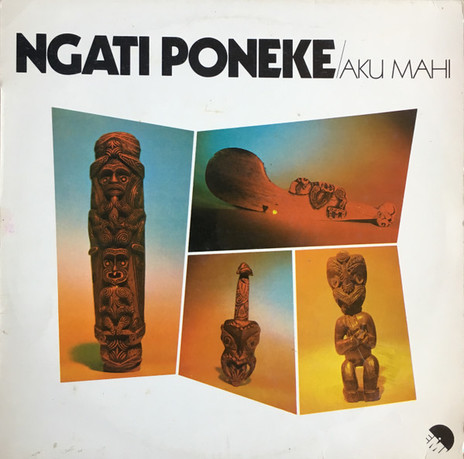
The Ngāti Poneke Māori Club album Aku Mahi (World Record Club, 1973). Wiremu Kerekere wrote four of the pieces.
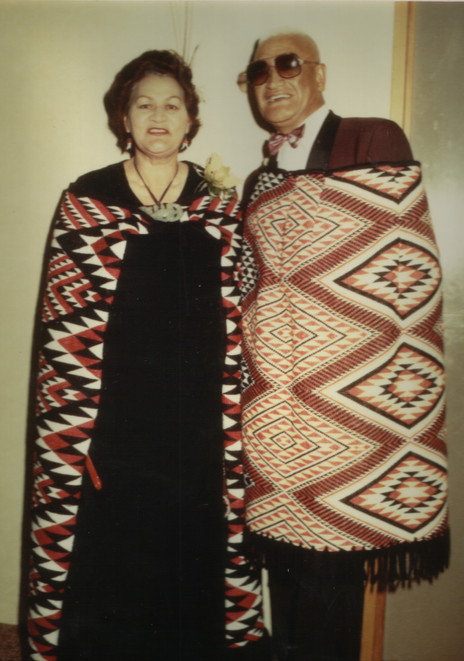
Mihi and Wiremu (Bill) Kerekere. Mihi is wearing the cloak of Te Kāhui Rangatahi, a kapa haka group of young people that Wiremu formed in 1969-70. She created the design for the group’s kākahu, including this full-length cloak. (The group went into recess in the late 70s and never restarted.) Wiremu is wearing “the Pōneke cloak” from the Ngāti Pōneke Young Māori Club and this cloak carries the Club’s kākahu pattern.
Photo credit:
Kerekere whānau collection
Discography
